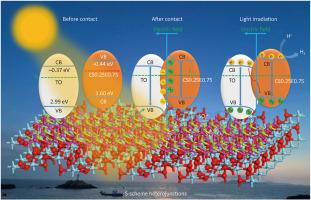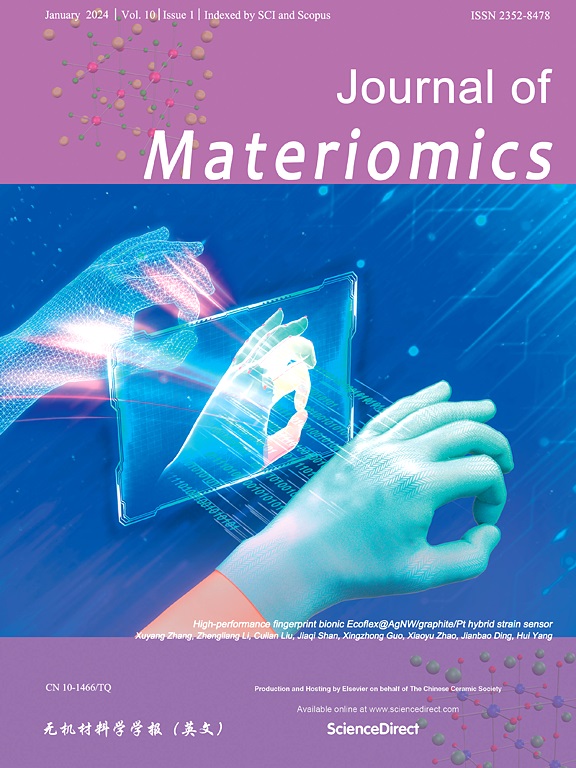Enhanced photocatalytic hydrogen production through tuning charge transfer in TiO2/CdSxSe1–x-DETA nanocomposites with S-scheme heterojunction structure
IF 8.4
1区 材料科学
Q1 CHEMISTRY, PHYSICAL
引用次数: 0
Abstract
In addressing the severe energy crisis, adopting efficient and reliable strategies is crucial. Photocatalysis technology, utilizing solar energy to convert it into hydrogen, offers an effective pathway to alleviate energy issues. In this study, we have successfully developed the TiO2/CdSxSe1–x-Diethylenetriamine (abbreviated as DETA) nanocomposites with an S-scheme heterojunction structure. By precisely adjusting the value of x (x = 0, 0.25, 0.50, 0.75 or 1.00), we optimized the charge transfer process, achieving efficient photocatalytic hydrogen evolution reaction. Specifically, the sample containing 20% (in mass) TiO2, denoted as 20-TO, exhibited the best photocatalytic activity. In particular, the activity of 20% (in mass) TiO2/CdS0.25Se0.75-DETA (abbreviated as 20-TO/CS0.25E0.75) reached 32.7 mmol·g−1·h−1, maintaining high hydrogen evolution performance over ten consecutive cycles (totaling 40 h). We used electron paramagnetic resonance (EPR), ultraviolet–visible diffuse reflectance spectroscopy (UV–Vis DRS), femtosecond transient absorption spectroscopy (fs-TAS) and theoretical calculations to comprehensively confirm that the heterojunctions in all nanocomposites conform to the S-scheme mechanism. This mechanism provides an optimal path for charge transfer. Comparative analysis through theoretical calculations revealed that the charge transfer efficiency between TO and CS0.25E0.75 was the highest, which correlates well with the experimental results of photocatalytic hydrogen evolution. This innovative nanocomposites enhances new energy technologies with its efficient charge transfer.

通过调整具有 S 型异质结结构的 TiO2/CdS Se1-DETA 纳米复合材料中的电荷转移提高光催化制氢能力
要解决严重的能源危机,采取高效可靠的战略至关重要。利用太阳能将其转化为氢气的光催化技术为缓解能源问题提供了一条有效途径。在这项研究中,我们成功开发了具有 S 型异质结结构的 TiO2/CdSxSe1-x-Diethylenetriamine (简称 DETA)纳米复合材料。通过精确调节 x 值(x = 0、0.25、0.50、0.75 或 1.00),我们优化了电荷转移过程,实现了高效的光催化氢进化反应。具体而言,含有 20% (质量分数)TiO2 的样品(记为 20-TO)表现出最佳的光催化活性。其中,20%(质量分数)TiO2/CdS0.25Se0.75-DETA(简称 20-TO/CS0.25E0.75)的活性达到了 32.7 mmol-g-1-h-1,在连续十次循环(共 40 小时)中保持了较高的氢气进化性能。我们利用电子顺磁共振(EPR)、紫外可见光漫反射光谱(UV-Vis DRS)、飞秒瞬态吸收光谱(fs-TAS)和理论计算全面证实了所有纳米复合材料中的异质结都符合 S 型机制。这种机制为电荷转移提供了最佳路径。理论计算的对比分析表明,TO 和 CS0.25E0.75 之间的电荷转移效率最高,这与光催化氢进化的实验结果非常吻合。这种创新的纳米复合材料可通过高效的电荷转移增强新能源技术。
本文章由计算机程序翻译,如有差异,请以英文原文为准。
求助全文
约1分钟内获得全文
求助全文
来源期刊

Journal of Materiomics
Materials Science-Metals and Alloys
CiteScore
14.30
自引率
6.40%
发文量
331
审稿时长
37 days
期刊介绍:
The Journal of Materiomics is a peer-reviewed open-access journal that aims to serve as a forum for the continuous dissemination of research within the field of materials science. It particularly emphasizes systematic studies on the relationships between composition, processing, structure, property, and performance of advanced materials. The journal is supported by the Chinese Ceramic Society and is indexed in SCIE and Scopus. It is commonly referred to as J Materiomics.
 求助内容:
求助内容: 应助结果提醒方式:
应助结果提醒方式:


